1982 San Marino Grand Prix race report

Gilles Villeneuve leads Ferrari team-mate Didier Pironi at a fateful San Marino Grand Prix
Motorsport Images
Ferrari First and Second
Imola, April 25th
The Grand Prix of San Marino, held on the undulating Imola circuit, was a straightforward affair. It was a battle between Ferrari and Renault, with two cars apiece, when the circuit opened for official testing on Friday morning at the scheduled time of 10 a.m. From the time the first lap was turned until late Sunday afternoon there were no problems as far as the spectators were concerned, you were either a Ferrari fan or a Renault fan, and each side made it clear which side was theirs. There were some Alfa Romeo fans, but they were eclipsed from the word go, an if you were not wearing red and waving a Ferrari flag you were wearing yellow and black and waving a Renault flag. By Saturday afternoon there were more than 40,000 protagonists around the circuit, and on Sunday for the race the organisers said there were 100,000 around the circuit. This was a bit of an exaggeration, but for sure there were 75,000 and there might have been 80,000, and by the end of the day most of them went home well contented.
At the beginning of the week before the race the FIA Tribunal had sat in Paris and decreed that running cars under the 580 kilogrammes limit was not acceptable, no matter how anyone interpreted the wording of the rules. In consequence Frank Williams withdrew his cars, as did Bernard Ecclestone and Colin Chapman, while the McLaren team was withdrawn amid a certain amount of dissension in the management. Others among the Cosworth-powered “special builders” who have to toe the line in the Ecclestone-Mosley FOCA group also withdrew, as did the Talbot team under the direction of Guy Ligier, though his reasons were obscure. Among the FOCA “hard-liners” Ken Tyrrell broke ranks and appeared in the paddock with his two cars, replacing Slim Borgudd with Brian Henton for “business” reasons and his cars carried advertising for Candy Appliances and Imola Ceramics in return for money. Among the lesser lights of the FOCA clan Gunther Schmidt ignored the “strike call” by Ecclestone and Mosley, and had his two yellow and white ATS entries in the paddock for Winkelhock and Salazar. Why some of the FOCA teams went on strike was not quite clear, but whatever the reason they certainly Iet-down their drivers and their sponsors.
Ferrari had their two “hard-chargers” Villeneuve and Pironi with the 1982 turbocharged 1 1/2-litre V6 cars and Renault had their 1982 turbocharged cars for Frost and Arnoux. The Toleman-Hart team had their turbocharged 4-cylinder cars for Warwick and Fabi, and Alfa Romeo had their V12-powered Tipo 182 cars for Giacomelli and de Cesaris. The Cosworth V8-powered specials were represented by the two Tyrrells, and the two ATS, as already mentioned, and the two Osellas for Jarier and Paletti. Sadly missed from the line-up were Piquet, Patrese, Rosberg and Lauda, but in all honesty the remaining 14 drivers who were forced to miss the event by the strike action of their team owner, were not going to affect the outcome or figure at the front. It was the supporting cast that was a bit thin on the ground. Of all the drivers who were deceived by their team owners only Lauda was seen in the paddock, making it very clear whose fault it was that he was not going to be seen in action and his sponsors Parmalat and Marlboro were not at all happy with the situation.
There was no point in weeping tears for the strikers, the San Marino GP was about to happen and the 14 entries that were ready were more important. The straight fight between Ferrari and Renault provided more than enough interest and one began to think it could be even better if each team fielded three cars, Lauda in a third Ferrari and Piquet in a third Renault was an intriguing thought, and if Patrese and Rosberg had appeared in the paddock looking for a drive there would have been no shortage of offers. With only 14 runners everyone was assured of getting on the grid, no there was no need for pre-qualifying on Friday morning and the timed afternoon sessions were only going to decide the order of the starting grid, not who was going to be in it. Although the Italian skies were blue and clear there was a cool breeze blowing which suited the turbocharged engines well and it was not long before the existing lap record time was being improved upon by both the Renault and Ferrari drivers. The Alfa Romeo team were not in the running and were making the excuse that their carbon-fibre monocoque 1982 cars were having to carry lead ballast to bring them up to 580 kilogrammes and this had upset their balance. In other words, like some of the FOCA teams, they had been dodging the rules and were now paying the penalty. In actual fact they were performing fairly normally if you study their past record.
Qualifying
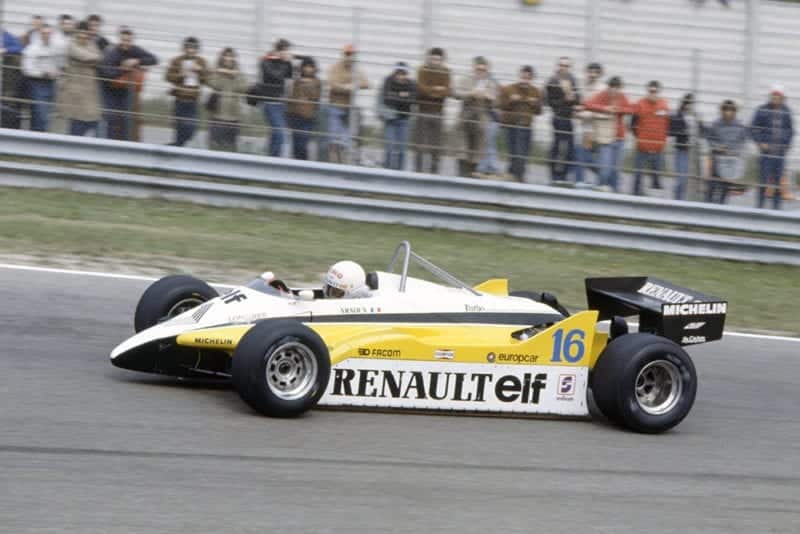
Rene Arnoux took pole for Renault
Motorsport Images
In the timed hour in the afternoon Renault were in big trouble with engines for Prost arrived back in the pits in his brand new car with smoke pouring from the right-hand side. He set off again in the spare car as Arnoux arrived back on foot to report that he had abandoned his car on the circuit amid smoke and a small oil fire. Consequently both drivers had to share the spare car to record any sort of competitive times, and Prost decided he liked it better than his new one and opted to keep it for the rest of the meeting. After making fastest lap of the day Frost relinquished RE358 to Arnoux who put in fourth fastest time with it. The Renault team were in the middle of the pit lane and were not looking too confident, while at the top end the Ferrari team were fairly happy, but not fast enough, though Villeneuve was second fastest. However, their happiness disappeared when Pironi failed to come round; a tyre burst and his Ferrari bounced along the guard-rails, ending up a pretty battered wreck, but he was unhurt and returned to the pits to continue practice in the spare car. Even though the time was better than existing standards from 1980 and 1981, he was only fourth in the list.
Due to a wet race last year the official lap record stood at 1 min. 36.089 sec. set by Alan Jones (FW0713) in 1980 and the fastest qualifying time was held by Arnoux (Renault) in the same year at 1 min. 34.523 sec, and now Prost was fastest with 1 min. 31.169 sec. and Pironi’s fourth fastest time was 1 min. 32.020 sec., all of which was reasonable for two years of development without cheating the rules.
At the other end of the pits the Toleman team, watched over by Ted Tolman himself, were desperately finishing off an engine change on Fabi’s car, due to a blow-up in the morning, but as time was running out he put in a few laps in Warwick’s racer in order to record a time, but the little Italian rattled about in the cockpit of the big Hampshire lad’s car and could not do justice to it. Warwick was in good form and recorded a creditable 1 min. 34.062 sec., which put him ahead of all the Cosworth-powered cars, but admittedly they were all “second-division” runners, and the ATS team were limited to only a handful of laps apiece as they were running on tyres left over from the Long Beach race, thanks to Ecclestone’s withdrawal of his IRTS tyre facility.
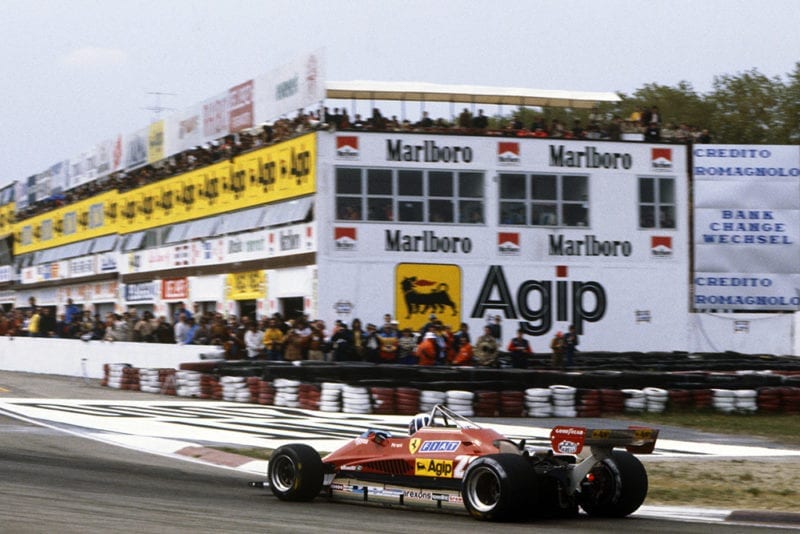
Didier Pironi put his Ferrari 4th on the grid
© Motorsport Images
On Saturday the breeze was cooler and conditions could not have been better for turbo-charged engines so that one was prompted to think that “someone up there” was smiling benevolently on the teams who were keeping faith with the race organisers and the paying public. In the Ferrari garages a car was being completed for Pironi using a renovated monocoque, bits from the crashed 056 car and new bits that had been destined for the next 126C2, which would have been 059. As it was not finished Pironi spent the morning test session in the T-car (057), while Villeneuve retained 058.
During some fast laps the brakes heated up so much that the fibre-glass air scoops to the front discs caught fire and the Canadian arrived back at the pits with flames and smoke licking round the front wheels. It was not as desparate as it looked, but the brake pad temperatures being recorded after the car had stopped were causing Ferodo’s man Alan Campbell to keep a close watch on things. The back leg of the Imola circuit is very hard on brakes, for after stopping from maximum speed for the Tosa hairpin, they are used very hard at the Aqua-Minerale chicane, again on the chicane on the high point of the circuit and then they are really slammed on at the foot of the hill for the Rivazza corners before returning to the start area. With little time to cool down the heat build-up at the foot of the hill is getting alarming. Looking at the smouldering fibre-glass ducts on Villeneuve’s car, Campbell remarked wryly “that little fellow has a very strong right foot.” Like Alain Front he also has remarkable depth perception on the approach to corners.
The ATS team experimented with Pirelli radial tyres on their rear wheels and used Avons on the front, as there were no suitable Pirellis to fit their front wheels, but both drivers decided it was not a good idea.
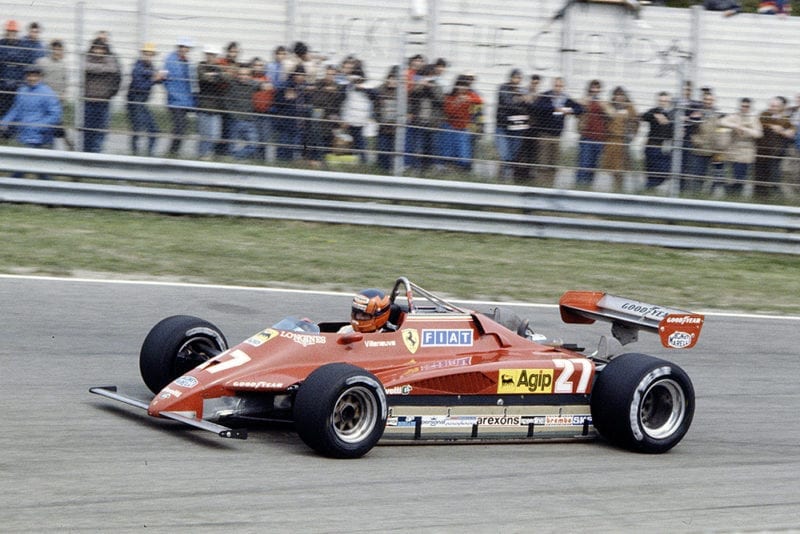
Gilles Villeneuve qualified 3rd for Ferrari
© Motorsport Images
In the afternoon, which was the final hour for deciding starting grid positions Prost was still using the Renault T-car, whose handling he preferred, and Pironi was still in the spare Ferrari as his new car was still being finished off. He eventually got into it ten minutes before the end of practice, but there was no time left to improve on his position made with the spare car. Villeneuve, Frost and Arnoux vied for pole position, all lapping at under 1 min. 31 sec. until Arnoux got in a really perfect lap and recorded 1 min. 29.765 sec. which stopped any further discussion. This ding-dong between Villeneuve (the obvious idol of the huge crowd) and the two Renaults kept the crowd enthralled and even though it ended up with the Renaults on the front of the grid everyone was happy because it had been a good fight and the little “Cannuck” had given everything he’d got for the honour of Maranello.
Down at the other end of the pits the Toleman team and Brian Hart were quite pleased for Warwick had gone quicker than the day before and Fabi was not far behind him. The quiet and polite Michele Alboreto once more made a good impression, beating both works Alfa Romeos with his Tyrrell 011, and added yet more to his steadily improving performances. Brian Henton, in the second Tyrrell 011 was not in the same class.
When it was all over and the starting grid had been drawn up Ken Tyrrell put in a fatuous protest against all the turbocharged cars. He claimed they were violating the rule that bans the turbine engine from Formula One. Turbine engines as primary power plants driving direct to the wheels through gearing or similar means are not allowed in Formula One; an exhaust-driven turbine driving an air compressor to increase the charge into a 4-stroke engine’s cylinders is not the same thing, as any first-year student of engineering knows.
Race
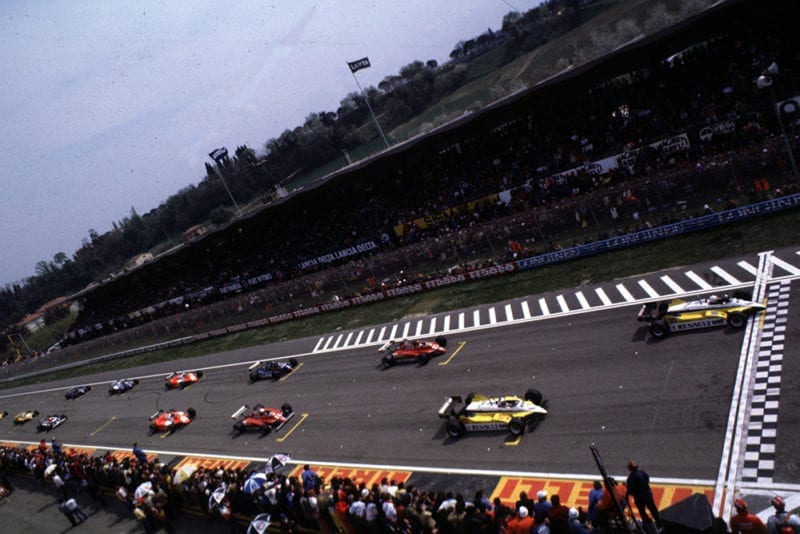
The Renaults lead away at the start
Motorsport Images
Much to the organisers relief and the chagrin of the “strikers” an enormous crowd turned up to see the Renault versus Ferrari battle. They would not have come to see a Williams versus Brabham battle, unless Villeneuve and Lauda had been driving the English cars. The morning half-hour warm-up session went off smoothly and the hillsides to the centre of the circuit were a sea of Ferrari banners with many Renault ones among them. If the race had been an equal confrontation between Ferrari and Alfa Romeo it hardly bears thinking about. The only consolation for the Alfa fans was news that Giorgio Francia, the test-driver, had been out on test in the V8 turbocharged 1 1/2-litre car, but not, unfortunately, at Imola. There was a mild flurry in the Renault pit as Arnoux’s engine seemed off-colour, so the decision was made to change it and the French mechanics did a remarkable job in just one hour, but of course, there was no opportunity to give it a test-run.
The start was scheduled for one minute after 3 p.m. to tie in with Television schedules, for though FOCA representatives had tried to convince the world that the race would be cancelled, hardly anyone in the TV scene listened to them. For Italy it was not warm, the skies were hazy and cloudy and the cool wind was still blowing. The 14 starters left the pit lane, covered a lap and formed up on the dummy-grid, but when they started up again to go round on the parade-lap behind Arnoux’s Renault, Paletti’s Osella was left behind. In the excitement of being in his first Formula One race the bespectacled Italian got the engine too rich and had to be push-started from the side-lines, by which time the remaining 13 cars were half way round the circuit. As they came through the final corners to form up under the red light there were only 12 cars, Warwick’s Toleman-Hart had died on him within sight of the pits but beyond assistance. It had done the same thing during the morning and it was later traced to an electrical connection that was faulty, so as the 12 cars took off under the green light poor Warwick had to abandon his car and walk back to the pits to become a spectator. Meanwhile Paletti could be heard on the back of the circuit about to start the race half a lap late.
It was Arnoux in the lead from Villeneuve and Pironi, with Prost fourth, Alboreto fifth, then the two Alfa Romeos of de Cesaris and Giacomelli with little Teo Fabi in the lone Toleman leading Javier’s Osella, the two ATS cars on their used Avon tyres, and the distant Osella of Paletti. Already Halton’s Tyrrell 011 had disappeared, its transmission failing as it left the line. It was soon clear that Prost was in trouble, his engine not pulling at all well and Arnoux and the two Ferraris soon drew away. At the end of lap three the Alfa Romeo of de Cesaris swept into the pits, its engine misfiring due to low fuel pressure caused by a faulty pump or faulty electrics. After the mechanics had fiddled with the installation the hero of Long Beach did another lap without improvement, and after one more try the car was wheeled away. Meanwhile all eyes were on the leading trio, for Arnoux was not getting away from the two red cars from Maranello and as they ran nose-to-tail, in the order Villeneuve, Pironi, they looked very menacing and the hush of the crowd was tense. Almost unnoticed Prost drove into the pit lane with his Renault engine sounding very flat and after the engineers had poked about a bit the car was withdrawn. The engine still ran but sounded very rough and there was no real power, so it was now all down to Rene Arnoux, and meanwhile Paletti’s debut race ended when his Osella suspension broke.
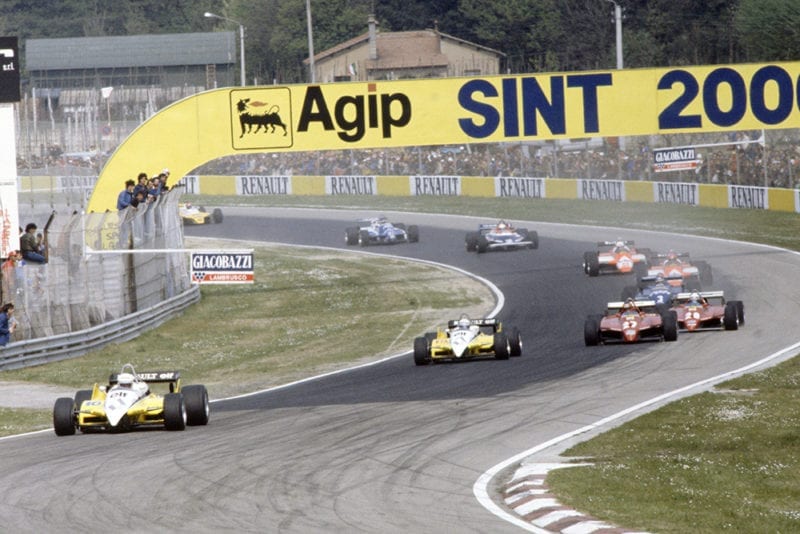
Arnoux leads Prost, Villeneuve and Pironi on the first lap
Motorsport Images
The distance between the first three cars varied hardly at all and the expectant crowd were clearly waiting for Villeneuve to attack for the lead. On lap 9 he got very close, and again on lap 13, but always the Renault was just out of reach, and Arnoux was going to keep it that way, even though his engine was running a bit rich and puffing out black smoke under hard acceleration. On lap 18 Villeneuve got so close that he locked a front wheel in endeavouring not to hit the Renault in the rear as they braked for the ess-bend by the pits. This put him off balance momentarily and a few laps later Pironi forced his way by into second place on lap 22, but Villeneuve went by his team-mate on lap 26 and zoomed up on to the tail of the Renault on the next lap and went by into the lead. The crowd let the whole of Imola know and everyone cheered and waved as Villeneuve led from Arnoux and Pironi, but the Renault driver wasn’t giving in that easily and at 30 laps, or half distance, the Ferrari, Renault, Ferrari trio were still nose-to-tail.
While all this had been going on the lads at the back had been enjoying themselves and pleasing the spectators, for Fabi resisted the onslaughts of Jarier’s Osella and Winkelhock’s ATS for 16 laps, while Salazar sat close behind them. It was a really spirited little dice and the “grey porridge” that usually divides the front of a race from the back was not missed at all. When Fabi saw his boost pressure begin to sag he succumbed to the ATS and then headed for the pits rather than risk further trouble. It took a long time to find the cause of the loss of boost but it was eventually traced to a split union on the boost-control unit and once that was replaced the engine ran like new and Fabi set off again, but too many laps behind to do anything but try and be classified last. Winkelhock “goofed” on lap 23, which let Jarier nip by and without affecting the scene Giacomelli’s Alfa Romeo expired out on the circuit with engine failure. He had been unable to keep up with Alboreto anyway, who in turn could not hope to keep up with the factory Ferraris and the Renault, so in consequence was having a lonely drive in fourth place.
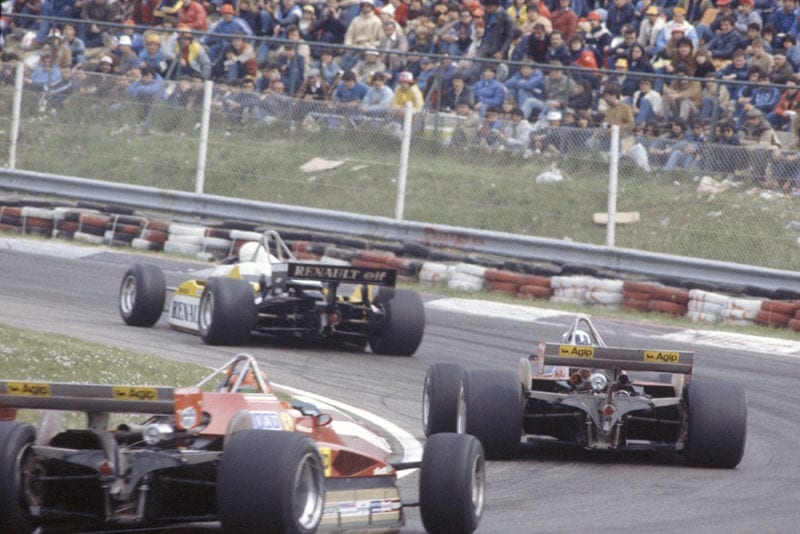
Arnoux leads Pironi and Villeneuve
© Motorsport Images
One lap after half-distance the cheering and waving ceased abruptly and there was no need to ask why, Arnoux had retaken the lead, and on lap 35 Pironi pressed by into second place again, but the three cars were still as if tied together, but on lap 41 Villeneuve was back into second place and the crowd cheered him on for they felt that “Villanova” alone was the only man who could beat the French car. Pironi dropped back a little as if to watch from a safe distance, and on lap 44 Villeneuve was once more right under the Renault’s rear aerofoil. As the car from Viry-Chatillon accelerated past the pits with its usual puff of rich-mixture black smoke from its exhaust pipes there was a sign of blue smoke amid the black and as Villeneuve ducked out of the slipstream to go by into the lead the Renault engine blew up in a cloud of smoke. The crowd went mad, Ferrari had vanquished the evaders and Villeneuve eased up so that Pironi joined him to reel off the remaining 15 laps in a triumphant “Ferrari Festival”. They were both given she “SLOW” signal and Villeneuve knocked the pace down from 1 mm. 35 sec. laps to 1 min. 37 sec., but Pironi promptly put in a lap at 1 min. 35 sec. and took over the lead. Villeneuve soon replied with an equally fast lap and it became obvious that team orders were being ignored and Pironi was out to win. He led for laps 46, 47 and 48 and then Villeneuve went ahead, but four laps later the Frenchman was back in the lead. He held it for six laps and then Villeneuve was past again as they started their last lap and the onlookers began to think it was a false alarm and that they had been playing to the gallery, except that there were reports of wheels on the grass and some pretty evil and close “thrust-and-parry”. Into the Tosa hairpin Pironi carved his way back into the lead in a manoeuvre that would have been heroic if his adversary had been a Renault, but on your own team-mate. . . ! That was it, Pironi stayed ahead for the rest of the lap and for a brief moment the thought crossed the mind that perhaps they were going to stage a dead-heat as a rude gesture to Renault and the FOCA strikers, but no, Pironi won by a few feet and Villeneuve was almost speechless afterwards.
When he got out of the car he was furious, but unlike some drivers in a similar situation who have slunk off to their Motorhomes to sulk, he controlled himself sufficiently to climb up on the winners rostrum with the victor and the unassuming Alboreto, who had netted a nice third place, but he did not congratulate the smiling Didier Pironi. The crowd were happy, it had been a nice day, Ferraris were first and second, and oh yes, an Italian driver was third and a small Italian manufacturer was fourth. It had been a nice day.
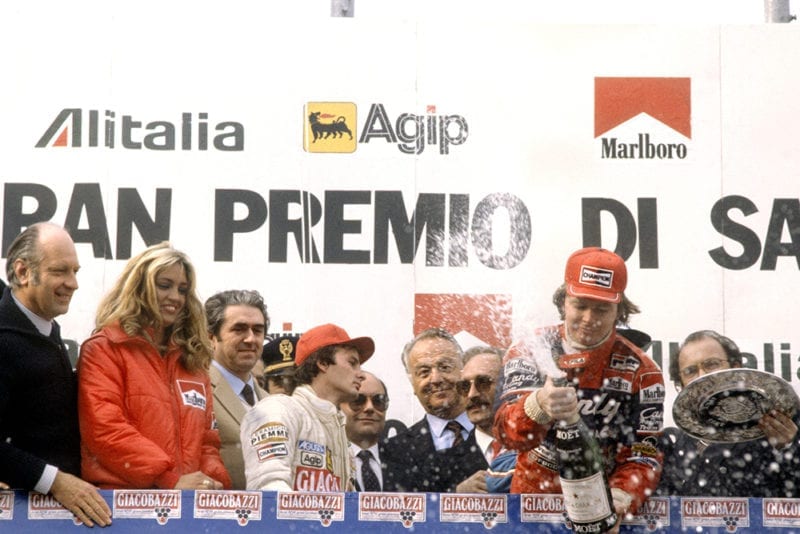
Pironi celebrates; Villeneuve averts his gaze
© Motorsport Images
In the post-race scrutineering the seven finishing cars were weighed and the results were: Pironi’s Ferrari 592.5 kgs. Villeneuve’s Ferrari 587.5 kgs., Alboreto’s Tyrrell 589.5 kgs., Jarier’s Osella 584 kgs., Salazar’s ATS 582 kgs., Winkelhock’s ATS 578 kgs., and Fabi’s Toleman 600 kgs. There was no argument, Winkelhock’s ATS was underweight and was disqualified from sixth place, all the more unfortunate for the young German driver as he lost the “back-of-the-field” dice when his ignition system played up and after a pit stop on lap 43 had soldiered on to the finish, Fabi could not claim sixth place officially as he was too many laps behind to be classified, though his car was running strongly.
What does that nice Mr. Tyrrell want to protest about now? — D.S.J.
